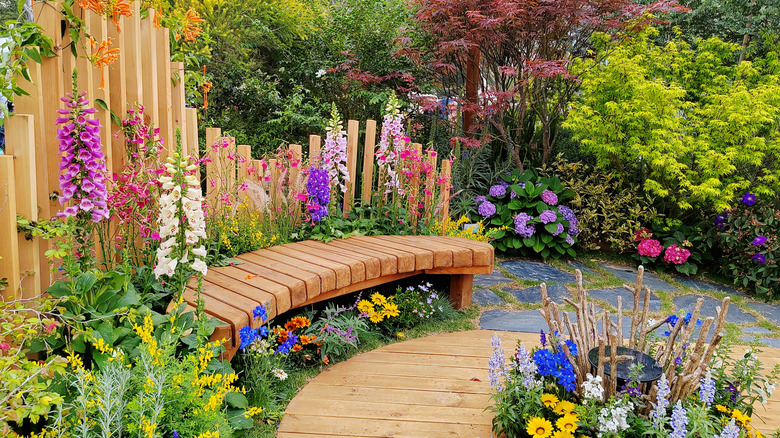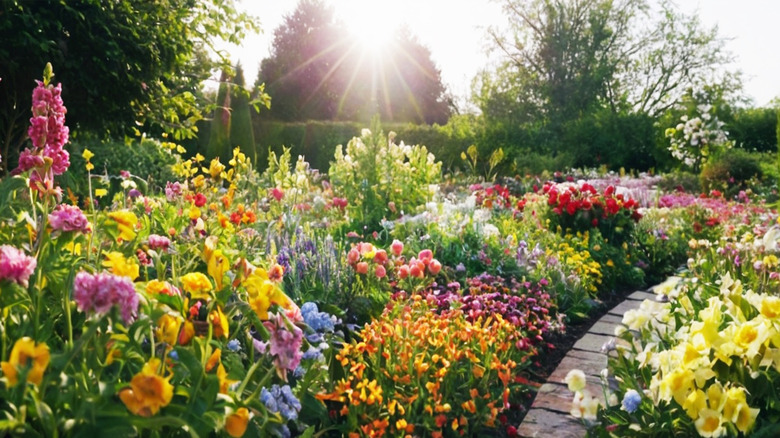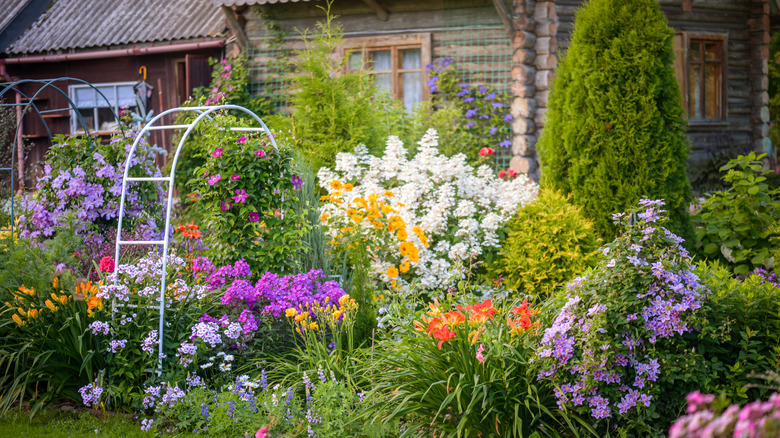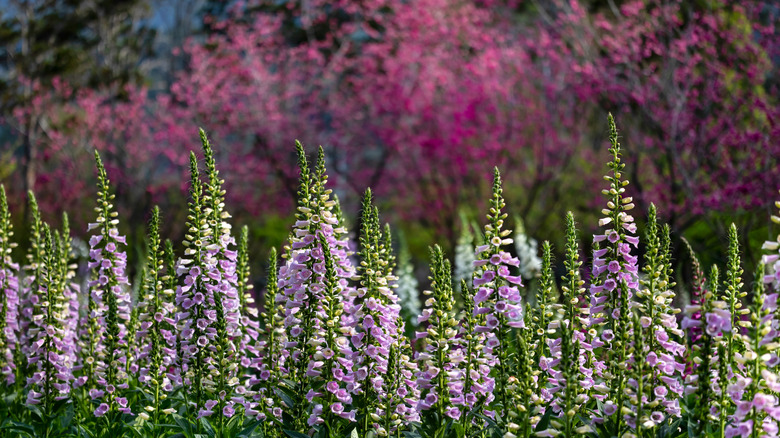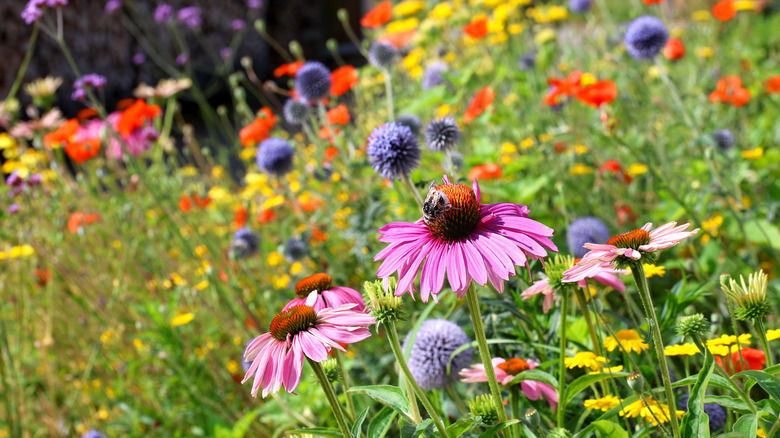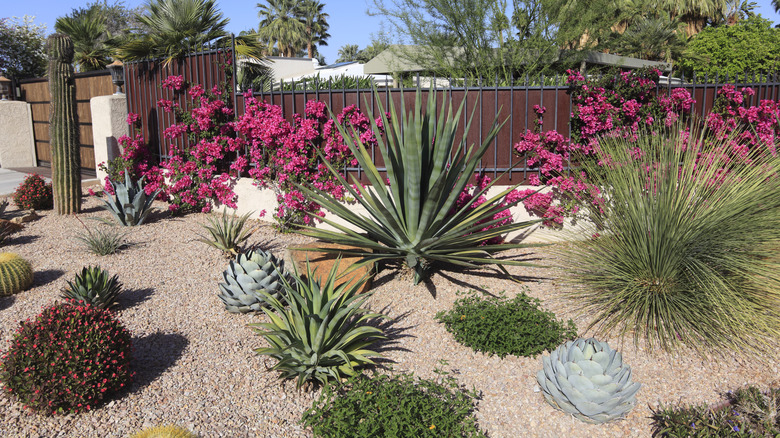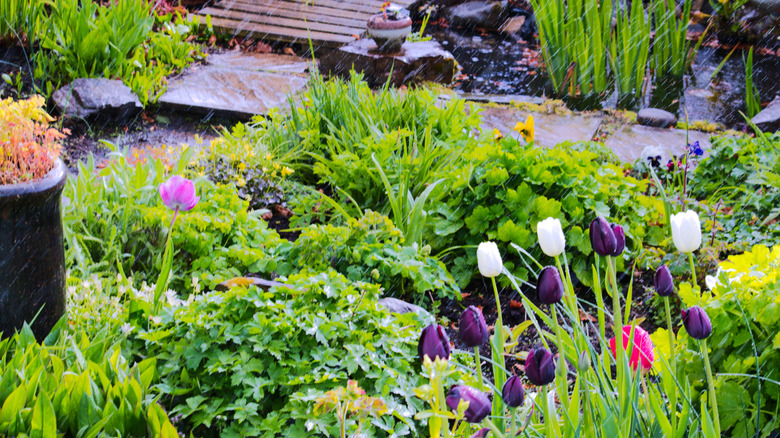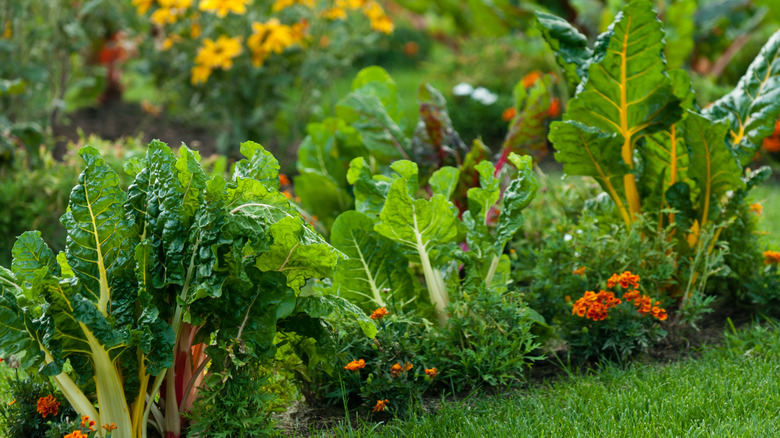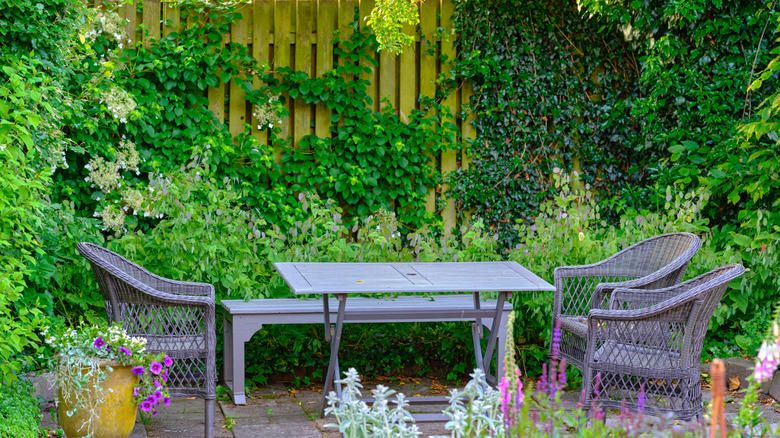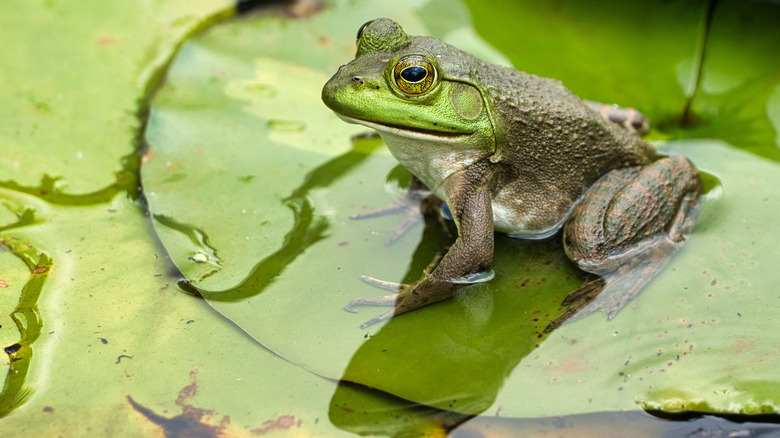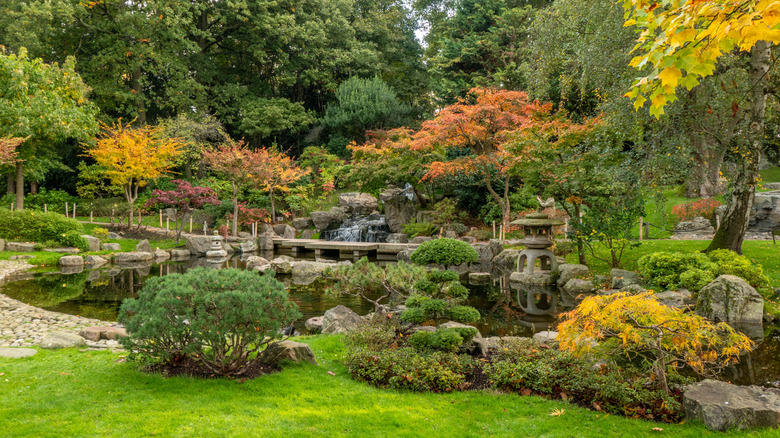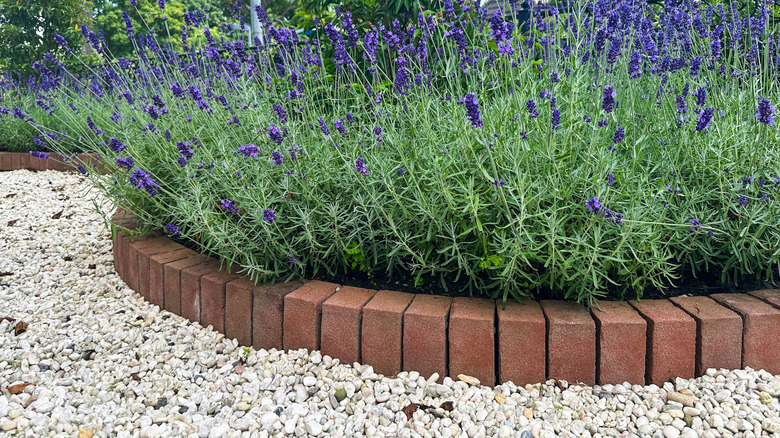12 Fall Gardening Trends You're Likely To See More Of In 2026
Based on what I've seen from leading designers and the displays at the U.K.'s Royal Chelsea Flower Show and other major garden events, for 2026 and beyond, it looks like there's a definite swing toward softer, flower-rich gardenscapes. The big shows pushed wildlife-first ideas, climate-savvy features, and woodland and cottage gardens. You'll notice more romance in borders, more layered shade, and more practical infrastructure for water and heat.
As a master gardener who specializes in permaculture and prefers my garden spaces to look natural and organic, I'm excited by the move back to softness, sympathy toward the climate and wildlife, and attention to working with nature instead of against her. But don't jump on these trends just because they're becoming fashionable. Take a look at what's going to be big for 2026 and choose those elements that match your taste, soil, hardiness zone, and what you've already got in your garden. And, whatever you choose, keep water management and soil health front-and-center. Go for durable, low-impact materials, peat-free growing media, and the right plants for the right environment if you want to build a truly resilient, on-trend garden.
Vibrant flower-forward, romantic borders
For the past few years, muted colors and pastels have been the go-to choice, but we're finally seeing a return to bold, colorful blooms and beautifully-scented romantic plantings. In 2026, you can expect to see whimsical, layered planting that moves away from the rigid minimalism of recent years, with pops of bright, vibrant, and deep color, heady perfumes, and a general sensorial style of planting, as seen in the RHS The Glasshouse Garden.
There are few flowers more romantic than the rose, and Chelsea 2025 made a big show of bringing roses back to mainstream personality. Apart from their addition to some of the more romantic and dramatic displays, several new rose cultivars were unveiled, including 'Catherine's Rose,' a pretty coral standard rose, named for Catherine, the Princess of Wales, and the 'King's Rose,' which is a lovely cerise and white striped shrub rose.
For layering, you want tall backbone shrubs and climbers with successional perennials of differing heights to give you a long blooming season. Finish your borders with paler, 'frothy' plants that soften the edges and contrast beautifully with the bolder colors of the rest of the space. Even though romantic gardens are colorful and softer, they still have a great deal of structure in their layering and plant choices.
The revival of cottage gardens
For a less structured and informal look, the cottage garden is back. It's nostalgic and charming, and is all about maximalism and abundance. The cottage garden is an extension of the cottagecore home trend, which is based on simplicity, natural freedom, and a romanticized ideal of the traditional English cottage garden. I honestly love this style of garden. I like my growing spaces vibrant, natural, and somewhat chaotic. It's a feast for the senses and supports birds and insect life, too.
You'll see arches and pergolas supporting rampant climbers with climbing roses, clematis, and honeysuckle for scent and height. Drift planting is a big part of cottage gardens. This is where you take groups of the same type of plant and repeat the groups in informal patterns and sweeping curves. You essentially use several of the same types of plants interspersed with plenty of other complimentary plants and colors repeated throughout your borders, so that the eye travels gently across the space. You want a riot of color, but not in a jarring way. Mix bold reds, purples, and jewels with pastels, whites, and splays of vibrant foliage.
If your aim is to support wildlife with your garden, choose plenty of self-seeding plants that will provide food and habitat for birds and insects. These will also randomly seed and fill your borders without intervention as the garden establishes itself. For the cottage garden aesthetic, I like useful, but beautiful, plants, so among the rudbeckia, nigella, cosmos, and sweet peas, I like to place aromatic herbs, echinacea, sunflowers, and chamomile.
Woodland and dappled shade gardens with trees
Woodland garden doesn't mean deep shade. Instead, dappled shade with native trees are the order of the day. At Chelsea, several installations, including the Wildlife Trusts' British Rainforest Garden and the Avanade Intelligent Garden both emphasized the importance of planting trees in urban spaces to combat climate change. I'm a huge fan of incorporating trees into gardens.
They support so much wildlife, create a lightly shaded spot that's perfect for sitting under during the summer, lower surrounding temperatures, hold soil together to limit erosion, and provide shade for plants that don't do so well in full sun. And, if you're smart, you'll plant productive trees native to or specifically bred for your region, such as apple, plum, elder, and walnut trees. Productive species can help feed a household, as well as local wildlife, while still providing dappled shade and pretty blossom in spring. Plenty of plants grow in dappled shade. You can grow actual woodland plants like dogwood for a touch of wild in your garden. Or, tame the wild feel a little by adding hostas, anemone, coral bells, hostas, hydrangeas, and ornamental ferns.
Wildlife-first gardening and rewilding to support local habitats
Wildlife-first gardening, or rewilding, is fast becoming a mainstream aesthetic and is a collection of simple ways we can help support insect and bird populations. It has elements of romantic, cottagecore, and woodland about it. But it's more than that. You don't need to let your whole space truly run wild and messy, either. Rewilding involves embracing native plants in your gardenscape in a smart, considered way that brings elements of the wild, while keeping things tidy and attractive.
Rewilding uses plants native to your specific climate, terrain, and conditions. This approach makes the garden incredibly efficient in terms of water usage, reducing how much water you need to provide. Let small patches of your lawn grow wild and unchecked, especially if it's a clover mix, or replace it with creeping myrtle or a similar grass alternative, as it provides color and valuable wildlife habitat. Plus, by choosing native ground covers, you won't need to rely on fertilizer and you'll improve your soil health and garden biodiversity. Put up bird boxes and insect boxes, and be rebellious and leave stems and seedheads in place, even in winter.
Hollow stems provide the perfect habitat for beneficial insects, including solitary bees and predatory insects. Dead seedheads provide valuable food in the lean winter months for birds and small mammals. And, in winter, your wildlife-first garden will have interesting shapes, texture, and color. Echinacea and poppy seedheads, for example, are very attractive in the winter landscape. Using native plant species in this way, and choosing species that will bloom successionally, creates a long flowering season that looks beautiful and provides an extended period of nectar, pollen, and seedheads. And don't be afraid to leave (or shred) fallen leaves as they make great mulch and overwinter shelter for terrestrial beetles.
Gravel gardens and xeriscaping to reduce water usage
Xeriscaping is a brilliant trend for those who live in drought-prone areas. And even those in more temperate climates can take aspects of xeriscaping and incorporate it into their own gardens. The premise is simply to use native plants and hardscaping to dramatically reduce or eliminate the need for irrigation.
In drought-tolerant regions and areas with thin soil, seriously consider ditching the grass for native ground cover that doesn't need feeding, irrigating, or mowing. Alternatively, go with native plants with gravel for ground cover and paving stones for pathways. Rocks, ledges, and boulders give texture, varied height, and visual interest, and also a way to funnel water where you want it. Using gravel as a base with no barrier beneath lets water penetrate quickly and deeply without excessive runoff or evaporation.
For planting, the trends is, and should be, native wildflowers and shrubs and, if they're native to your hardiness zone, succulents. Xeriscaping with native plants, rocks, and gravel doesn't need to be barren and sparse. If your soil is thin, add plenty of organic matter and top dress with a thick layer of mulch. Your garden can easily be a lush natural oasis with this gardening trend that reduces your water usage and reliance on chemicals, and one that becomes a haven for native wildlife.
Rain gardens that makes use of the elements
I love the rain garden trend. It's a brilliant way to make use of whatever rainfall and excessive water runoff you have. Instead of planting water-sensitive plants in areas you know get too much water, you specifically design a garden area to use that excess water. The same applies if you live in areas prone to heavy storms. You direct the water to a specific area of your outdoor space and turn it into a rain garden.
The idea of a rain garden is that it collects rain and stormwater diverted from your house, driveway, roof, and other hard surfaces, and lets it soak into the soil. That way, the sediments in the runoff settle, the plants make use of the nutrients, and the soil filters out pollutants before the water soaks away into the groundwater. You choose an area at least 16 feet from the foundation of a building, and dig out a depression that can hold runoff and heavy rainfall for 48 hours until it can drain away. Rain gardens reduce pollution and erosion. You can channel the water by using small downward sloping channels or rain chains.
In your rain garden, plant a variety of wet-tolerant plants, like dogwood, guelder roses, flag irises, sedges, miscanthus, or geraniums. Then add somewhat wet-tolerant plants like cone flowers, day lilies, and bee balm around the edges. Just avoid planting anything medicinal or edible in rain gardens that get high levels of storm runoff, as the water carries pollutants you don't want to consume.
Gardens full of edimentals and useful ornamentals
Now, as I was saying earlier, I like my garden to be beautiful and useful, so I am delighted by the edible-ornamental trend that's rapidly gaining in popularity. So many edible plants are strikingly beautiful when they're in bloom. Consider cherry blossom — it's gorgeous. Even your hedges can be useful and attractive if you choose plants like rosemary, blueberry, sloes, or hazel. Aside from supporting wildlife, you're getting big harvests of free food from a garden that looks stunning. At Chelsea 2025, the Garden of the Future exhibited sustainability and food security by incorporating climate-resistant edibles like chickpeas and sweet potatoes.
Chard, kale, and rhubarb make colorful and interesting textural additions. Nasturtiums have striking colors and have a lovely, bright, peppery flavor. Just add the flowers to your salad — they're delicious. We've already covered productive trees, but you can also enjoy aromatic herbs like sage and purple basil, while using them for border fillers and lovely flowers over a long blooming season. And then there's ground covers like creeping thyme and oregano that grow rapidly, fill gaps, and smother weeds.
You can also grow pole beans, squashes, and pumpkins vertically for a unique and interesting look. Then there's medicinal plants like echinacea, calendula, and bee balm that also make stunning ornamental additions. I'm not suggesting you have to go full-on edible, of course. But even incorporating just one or two edible plants into your garden is a big step in the right direction. And, I'll say it again: free food!
Vertical gardening, especially for urban homes
Vertical gardening was trendy over a decade ago, but it's coming back in a big way. New build properties and urban homes tend to have smaller plots and vertical gardening is a fantastic way to create your very own urban haven and make use of vertical space that's often wasted. It also brings food and habitat for wildlife to areas where it's often scarce, boosting biodiversity. Plus, in hot climates and urban environments, vertical gardens help provide shade and cool the immediate area.
You can get started fairly easily, too. All you need is trellis, wire anchors on your wall, or a pergola or similar structure if you have the room. Then add climbing plants that thrive in your area. Perennial vines star jasmine, moon flower, cape honeysuckle, or purple passionflower bring lush greenery and charming flowers, as well as heady scents. You could even add a climbing rose for an extra trending touch.
This vertical "wall" creates a beautiful and dramatic backdrop. But don't stop there. Add layers of shade-loving plants of different heights and colors that can thrive beneath the climbers. Though normally reserved for the back of a border, in a vertical garden, these plants work as the second layer. You could use foxgloves, bear's breeches, Japanese anemones, hostas, astilbe, or aconite. If you have space, add some shorter stature plants like compact hostas, fuchsias, salvias, or bleeding hearts. Finishes with shorter stature plants like lavender or ground covers like lobelia.
Micro-ponds and mini wetlands for positive environmental impact
As I already noted, water management featured heavily at the Royal Chelsea Flower Show. The Flood Resilience Garden won silver and the Boodles Raindance Garden exhibited rainwater channeling and mini ponds. Efficient water usage is a hugely important issue for the environment — but also for your wallet. If you can reduce the supplemental water you have to give, you save money on your utility bills. If you can harvest and channel water to where you want it to go, you keep it away from building foundations where it could cause costly damage over time.
Building in mini wildlife ponds or wetland areas into your gardenscape helps with all of these things and boosts biodiversity. I really liked the Boodles Raindance garden, which had rills directing water to a series of mini ponds surrounded by woodland edge plantings. The trend here is about incorporating those micro-ponds and wetlands seamlessly. The Raindance exhibit did this beautifully, with round ponds, round pavers or stepping stones. Even the seating area had a circular theme, and many of the plant choices also carried the circular or spherical theme.
Multi-stem trees that create small urban canopies
Yes, we're going to mention trees again, because they featured so heavily at Chelsea this year. But specifically, multi-stem trees that create small, light canopies that can really bring beauty and health to urban gardens. Trees filter the air, sequester Co2 and other pollutants, and release precious oxygen. Every single tree you plant improves air quality. Plus, especially in urban settings, they provide much-needed habitat and shelter for all kinds of wildlife. Trees also reduce flooding risk as the stems and leaves catch water, reducing the amount that reaches the ground by around 45%.
Then there's the heat island effect. Urban locations tend to be hotter than their rural counterparts, but trees and other greenery have a natural cooling effect. Even the Environmental Protection Agency recommends using trees to reduce heat islands. Choose multi-stem trees that will give you small, light, airy canopies for dappled shade. Compact birch, maple, and willow trees are all excellent options, as are Californian lilacs and evergreen strawberry trees. Dwarf or compact fruit and nut trees give you (and the wildlife) lots of food, too. And you can train, or espalier, them into the shape you want, although this reduces their function as canopies.
Japanese-inspired gardens that promote tranquility
The Chelsea gold medal winner for 2025 was the Japanese Tea Garden, and you'll see many of the elements here carried into residential gardens in 2026. Japanese-inspired gardens tend to be places that promote tranquillity and calmness. Traditional Japanese-inspired meditation gardens include key components like stone, water, plants, and ornaments. You'll see different elevations and an interesting mix of stones and hardscaping interspersed with lively trees, shrubs, flowers, and ground covers. Colorful foliage features heavily for year-round color. The rocks and hardscaping touches shouldn't be overly dominant and should be sympathetic to the plants.
To keep things eco-friendly, use porous base layers where you can, instead of concrete, to reduce runoff and allow rainwater to soak through. A Japanese-inspired garden is also the perfect place to incorporate multi-stem trees and micro ponds or water features, capturing multiple trends and doing your bit for the environment and to fight climate change all at the same time.
Permeable, low-impact hardscaping for proper water drainage and runoff
Because helping the environment and fighting climate change featured so heavily in the big flower shows this year, naturally the materials used supported that emphasis. And, as the public becomes more conscious of these issues and just how much power they have to bring real change, I expect to see this trend continue and expand. We've already touched on all of these issues. Trees to help mitigate heat islands and rain gardens to manage runoff — but low-impact materials for the hard parts of your garden are just as critical.
Impermeable surfaces like concrete and grouted pavers don't give rainwater or storm water any way to dissipate safely into the ground. Instead, you get a huge amount of runoff that picks up pollutants, strips soil of nutrients, and ends up directly in waterways where the pollutants can damage wildlife and human health. Plus, the water table doesn't get adequately topped up. But when you use permeable pavers, gravel, mulched beds, and low-maintenance ground covers, you let the water pass safely through the surface to slowly percolate into the groundwater, boosting the water table and your overall garden health. And, you can use French drain-style rills to direct runoff to a rain garden or holding area where it can safely soak into the soil. Gravel works great for drainage as a permanent mulch around well-established perennials.
